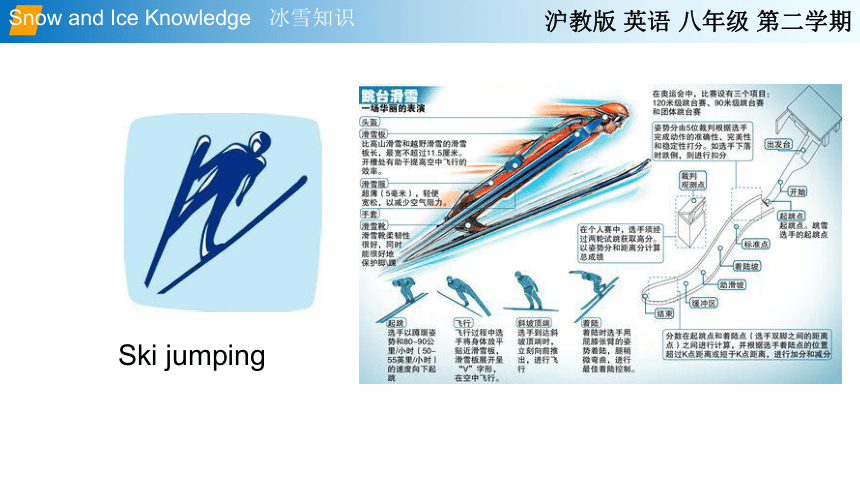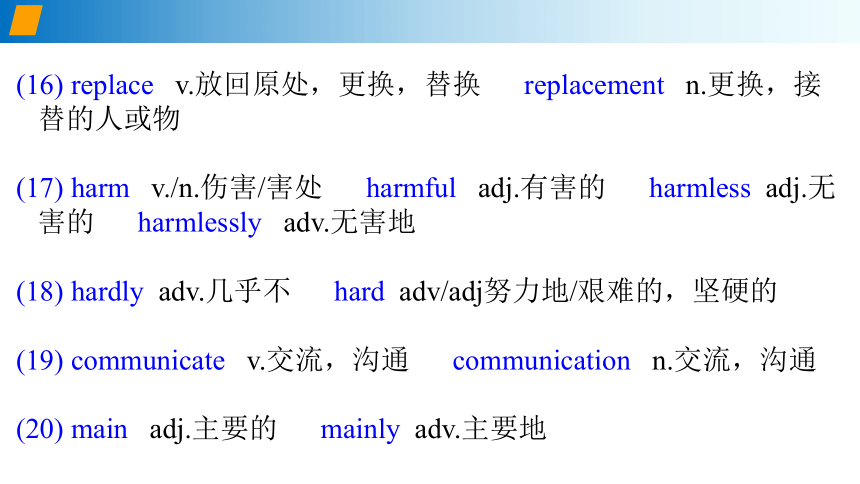Unit 1 Trees 第2课时 语法知识及拓展(课件)-2021-2022学年八年级英语下册同步备课系列(牛津上海版)
文档属性
| 名称 | Unit 1 Trees 第2课时 语法知识及拓展(课件)-2021-2022学年八年级英语下册同步备课系列(牛津上海版) |

|
|
| 格式 | pptx | ||
| 文件大小 | 496.8KB | ||
| 资源类型 | 试卷 | ||
| 版本资源 | 牛津上海版(试用本) | ||
| 科目 | 英语 | ||
| 更新时间 | 2022-02-18 13:58:37 | ||
图片预览












文档简介
(共33张PPT)
Lead in—轻松快乐驿站
Teacher: Why aren't you drawing, Mary
Mary: I just drew a picture of a kitten drinking milk.
Teacher:That's fine, but where's the kitten
Mary: It ran away after all the milk is gone.
老师:你为什么不画画,玛丽?
玛丽:我刚刚画完了一幅小猫喝牛奶的图片。
老师:很好,那么小猫在哪里?
玛丽:它喝完牛奶后就跑了。
沪教版 英语 八年级 第二学期
Snow and Ice Knowledge 冰雪知识
Ski jumping
沪教版 英语 八年级 第二学期
1. 单词默写
沪教版 英语 八年级 第二学期
Check
( words+expressions+reciting+homework+错题回顾)
destroy v.破坏,毁坏 destruction n.毁灭,毁坏
(2) product n.农产品 production n.产品(工业方面) producer n.制片人,制作者 produce v.生产
(3) fact n.事实 factor n.因素
(4) interested adj. 感到有兴趣的. interesting adj.令人产生兴趣的 interest n.兴趣,爱好
(5) pure adj.纯净的 purely adv.纯净地
(6) nature n.自然 natural adj.自然的 unnatural adj.不自然的 naturally adv.自然地
(7) burn v./n.燃烧/烧伤 burning adj.(只用于名词前)燃烧着的,雄心勃勃的,迫在眉睫的
(8) live v./adj.居住/现场的 living adj.活着的 alive adj.活的 lively adj.活泼的
(9) exchange v./n.交流,交换 change v./n.改变,替换
(10) fighter n.战士 fight v./n.战斗/打架
(11) noise n.喧闹声,嘈杂声,噪音 noisy adj吵闹的,喧闹的,嘈杂的. noisily adv.吵闹地
(12) breathe v.呼吸 breath n.呼吸
(13) scientist n.科学家 science n. 科学 scientific adj.科学的
(14) warn v.警告 warning n.警告,告诫
(15) chemical adj.化学的 chemicals n.化学物质(复) chemistry n.化学(学科) chemist n.化学家
(16) replace v.放回原处,更换,替换 replacement n.更换,接替的人或物
(17) harm v./n.伤害/害处 harmful adj.有害的 harmless adj.无害的 harmlessly adv.无害地
(18) hardly adv.几乎不 hard adv/adj努力地/艰难的,坚硬的
(19) communicate v.交流,沟通 communication n.交流,沟通
(20) main adj.主要的 mainly adv.主要地
(21) announce v.公告,宣布 announcer n.发言人 announcement n.声明,公告
(22) windsurf v.冲浪 windsurfing n.冲浪运动
(23) thank v.感谢 thankful adj.感谢的,感激的
(24) contain v.容纳 container n 容器
(25) enjoy v.享受 enjoyment n.享受,快乐 enjoyable adj.令人愉快的
(26) leader n.领导者 lead v.领导
(27) in the end最后(可用于将来时)
at the end of 在…末(可指时间或空间)
by the end of(到…为止)(用于时间)
on the end of在…的末端上
2.日常表达默写
搜集有关污染的课题资料 collect some facts for a project on pollution
2. 在…的末端 on the end of
3. 活着的生命 living things
4. 使它们尝起来很难吃 make them taste nasty
5. 破坏我们最好的环境卫士 destroy our best fighters against pollution
6. 将…连在一起 join…together
7. 完整一年 a whole year
8. 天然空调 natural air conditioners
9. 提醒它的邻居 warn its neighbors
10. 喜欢呼吸纯净、清爽的空气 enjoy breathing pure cool air
Grammar
The Present Continuous Tense
现在进行时
一、现在进行时表示的意义
1. 表示现在(说话瞬间)正在进行或发生的动作,强调动作发生的时间是此时此刻。
e. g. I am reading an English book. 我正在看一本英语书。
She is watching TV. 她正在看电视。
2. 表示目前一段时间内的活动或现阶段正在进行的动作。
e. g. What lessons are you studying this week 你们本周学习哪些课程了?
Tom’s parents are working in China this year. 汤姆的父母今年一直在中国工作。
二、现在分词的构成
1. 直接在动词原形末尾加-ing。
e.g. teach- teaching play- playing look -looking go – going
2. 以不发音的字母e结尾的动词,先去掉e,再加-ing。
e.g. write- writing take- taking live- living give- giving
3. 以重读闭音节结尾的动词,且词尾只有一个辅音字母时,应双写该辅音字母再加-ing。
e.g. put- putting run- running begin- beginning swim – swimming
三、现在进行时的句子结构
现在进行时是由“助动词be+动词的现在分词”构成,be(am,is,are)是助动词。其句子构成为:
1. 肯定句由“主语+be+v. -ing+其他”构成。
e. g. I am cleaning the classroom. 我正在打扫教室。
They are playing the piano. 他们正在弹钢琴。
2. 否定句由“主语+be+not+v. -ing+其他”构成。
e.g. He is not watching TV. 他没在看电视。
They are not writing. 他们没在写东西。
3. 一般疑问句由“Be+主语+v. -ing+其他?”构成,其肯定答语为“Yes,主语+be”,否定答语为“No,主语+be+not"。
e. g. -Is she listening to the music 她正在听音乐吗?
-Yes, she is. /No, she isn't. 是的,她在听。/不,她没在听。
-Are they running 他们正在跑步吗?
-Yes, they are. /No, they aren't. 是的,他们在跑。/不,他们没在跑。
4. 特殊疑问句由“特殊疑问词+be+主语+v. -ing+其他?”构成。
e.g. What are you doing 你们正在做什么?
Who is he talking to 他正在和谁谈话?
四、现在进行时的标志
1. 句中有副词now时,常表示动作正在进行,这时要用现在进行时。
e. g. The children are playing football now. 孩子们现在正在踢足球。
2. 句首有look, listen提醒注意时,提示我们动作正在进行,这时要用现在进行时。
e. g. Look!A train is coming. 看!火车来了。
Listen! He is reading. 听!他正在朗读。
3. 句首有表示钟点的时间时,提示动作正在进行,这时要用现在进行时。
e.g. It's six o’clock. My mother is cooking breakfast. 现在六点了,我妈妈正在做早餐。
4. 根据语境或上下文理解,如果表示动作正在进行,这时要用现在进行时。
e. g. Don't make noise. The baby is sleeping. 不要吵,这个婴儿正在睡觉。
五、没有进行时态的动词
在英语中有一些动词没有或很少有进行时态。到目前为止,同学们学过的没有进行时态的动词可分为以下几类:
1. 表示感觉的感官动词,如see“看见”,hear“听见”,find“找到”,notice “留意”等动词。
e.g. Do you hear the noise of a plane 你听到飞机的声音了吗?
We see him. 我们看见他了。
【友情提示】表示感觉的动词,如listen to,look at可用于现在进行时态中,强调看的动作而非结果。
e.g. They're listening to the teacher. 他们在听老师讲课。
2. 表示态度和感情、心理状态等意思的动词,如like“喜欢”,love“爱”,know“知道”,want“需要”,hope“希望”,hate“恨”,think“认为”,believe“相信’’等。
e.g. I like dogs. 我喜欢狗。
I want to go out for a walk now. 我现在想出去散步。
3. 当have/has表示“拥有”时。
e. g. I have a lot of books. 我有许多本书。
【友情提示】当have/has表示“吃饭;开会;玩得愉快”等意思时,可用于进行时态。
e.g. We are having a good time. 我们正玩得开心。
4. 表示状态的be动词“是”。
e.g. He is at home. 他在家里。
六、现在进行时和一般现在时的区别
1. 时间状语:
(1) 一般现在时表示经常性、习惯性的动作或状态,强调的是经常性和习惯性,通常与always,often,sometimes,
usually等频度副词以及in the day, in the morning/afternoon/evening, on Sundays, at weekends等短语连用。
e.g. My father often reads books after dinner. 我的父亲经常饭后看书。
(2) 现在进行时表示讲话时或目前一段时间内正在发生的事情,通常与now, these days, at this time等时间状语连用。
e.g. He's playing the piano now. 他现在正在弹钢琴。
Look! They are watching TV. 看!他们正在看电视。
2. 谓语动词:
(1) 一般现在时谓语动词的构成有三种情况be动词用am, is, are;实义动词用原形或第三人称单数形式;情态动词+动词原形。
e.g. My brother is a policeman. 我的哥哥是一名警察。
She doesn’t wear a white uniform. 她不穿白色工作服。
He can speak English. 他会说英语。
(2) 现在进行时的谓语动词构成为:be(am, is, are)十v. -ing。
e.g. Are you cleaning the classroom 你正在打扫教室吗?
She is eating dinner. 她正在吃饭。
易错点名师点拨
【错因分析】 没有根据题意正确判断动词的时态
【例1】 Don't make so much noise. My father .
A.is working B. works C. worked D. will work
【典型错误】 B
【正确答案】 A
【名师点拨】 本题的意思是要求对方不要制造噪音,同时根据选项可推断父亲正在工作。此题考查的是现在进行时态。现在进行时态表示动作正在进行,其结构为be(am, is, are)+v-doing。通常,现在进行时态之前有look,listen等词开头来提醒注意,或者跟now,at the moment,at present等时间状语连用。
【错因分析】
感官动词see的用法:主动语态的语法结构是see sb. do sth./see sb. doing sth.;
被动语态应为be seen to do sth.
【例2】 He was seen_____________(enter) the supermarket.
【典型错误】 enter; entering
【正确答案】 to enter
【名师点拨】 类似see的用法的感官动词还有:
hear sb. do sth. →sb. be heard to do sth.
make/let/have sb. do sth.→sb. be made/let/had to do sth.
see/watch/notice sb. do sth.→sb. be seen/watched/noticed to do sth.
要区别hear sb. doing sth. →sb. be heard doing sth. doing作为主语补足语时,直接写下来即可。
例:We often hear the twins sing songs in the next room.
→The twins are often heard to sing songs in the next room.
We saw the boys playing football in the playground at 9 a.m.
→The boys were seen playing football in the playground at 9 a.m.
【例3】 The policeman helped him find his____________(miss) motorbike.
【典型错误】 miss
【正确答案】 missing
【名师点拨】 动词的现在分词,常常起修饰的作用并做定语,用来说明名词的用途、性质和功能。如sleeping room, washing room, living room, listening skills, writing practice, sneezing record等。
例:Would you please stop laughing Or my sleeping(睡着的)baby may wake up.
【错因分析】 miss词性为动词,在此处动词的现在分词形式
作motorbike的定语。
【错因分析】 对感官动词 see的用法不清楚。
【例4】 When I passed the window, I saw some boys_____________TV.
A. watched B. watch
C. watching D. have watched
【典型错误】 A; B
【正确答案】 C
【名师点拨】 从此题的题意和提供的答案来看,应该用see sb. doing sth. 这种形式。在感官动词see后面,既可以接不带to的动词不定式做宾语补足语,也可以接动词-ing形式做宾语补足语,即see sb. do sth. 和see sb. doing sth.。前者表示动作的全过程已结束,后者表示动作的一部分正在进行。如:
I saw her read the book. 我看见她读这本书。(说明她读完了这本书)
I saw her reading the book. 我看见她正在读书。(说明动作正在进行,这本书没有读完)
同样,watch, hear也有相同的用法。
1、Mike is from America. He____________English.
A. spoke B. will speak C. speaks D. had spoken
随堂小练
2、-Where is Peter
-He____________volleyball with his friends in the school gym.
A. plays B. played C. is playing
1、【答案】 C
【解析】 此题考查一般现在时。根据题意可知美国人说英语,故答案为C。
2、【答案】 C
【解析】 根据句意及上下文提示可知“彼得正和他的朋友们在学校体育场打排球呢”,故答案为C。
愿君皆有所获,皆有所得
Lead in—轻松快乐驿站
Teacher: Why aren't you drawing, Mary
Mary: I just drew a picture of a kitten drinking milk.
Teacher:That's fine, but where's the kitten
Mary: It ran away after all the milk is gone.
老师:你为什么不画画,玛丽?
玛丽:我刚刚画完了一幅小猫喝牛奶的图片。
老师:很好,那么小猫在哪里?
玛丽:它喝完牛奶后就跑了。
沪教版 英语 八年级 第二学期
Snow and Ice Knowledge 冰雪知识
Ski jumping
沪教版 英语 八年级 第二学期
1. 单词默写
沪教版 英语 八年级 第二学期
Check
( words+expressions+reciting+homework+错题回顾)
destroy v.破坏,毁坏 destruction n.毁灭,毁坏
(2) product n.农产品 production n.产品(工业方面) producer n.制片人,制作者 produce v.生产
(3) fact n.事实 factor n.因素
(4) interested adj. 感到有兴趣的. interesting adj.令人产生兴趣的 interest n.兴趣,爱好
(5) pure adj.纯净的 purely adv.纯净地
(6) nature n.自然 natural adj.自然的 unnatural adj.不自然的 naturally adv.自然地
(7) burn v./n.燃烧/烧伤 burning adj.(只用于名词前)燃烧着的,雄心勃勃的,迫在眉睫的
(8) live v./adj.居住/现场的 living adj.活着的 alive adj.活的 lively adj.活泼的
(9) exchange v./n.交流,交换 change v./n.改变,替换
(10) fighter n.战士 fight v./n.战斗/打架
(11) noise n.喧闹声,嘈杂声,噪音 noisy adj吵闹的,喧闹的,嘈杂的. noisily adv.吵闹地
(12) breathe v.呼吸 breath n.呼吸
(13) scientist n.科学家 science n. 科学 scientific adj.科学的
(14) warn v.警告 warning n.警告,告诫
(15) chemical adj.化学的 chemicals n.化学物质(复) chemistry n.化学(学科) chemist n.化学家
(16) replace v.放回原处,更换,替换 replacement n.更换,接替的人或物
(17) harm v./n.伤害/害处 harmful adj.有害的 harmless adj.无害的 harmlessly adv.无害地
(18) hardly adv.几乎不 hard adv/adj努力地/艰难的,坚硬的
(19) communicate v.交流,沟通 communication n.交流,沟通
(20) main adj.主要的 mainly adv.主要地
(21) announce v.公告,宣布 announcer n.发言人 announcement n.声明,公告
(22) windsurf v.冲浪 windsurfing n.冲浪运动
(23) thank v.感谢 thankful adj.感谢的,感激的
(24) contain v.容纳 container n 容器
(25) enjoy v.享受 enjoyment n.享受,快乐 enjoyable adj.令人愉快的
(26) leader n.领导者 lead v.领导
(27) in the end最后(可用于将来时)
at the end of 在…末(可指时间或空间)
by the end of(到…为止)(用于时间)
on the end of在…的末端上
2.日常表达默写
搜集有关污染的课题资料 collect some facts for a project on pollution
2. 在…的末端 on the end of
3. 活着的生命 living things
4. 使它们尝起来很难吃 make them taste nasty
5. 破坏我们最好的环境卫士 destroy our best fighters against pollution
6. 将…连在一起 join…together
7. 完整一年 a whole year
8. 天然空调 natural air conditioners
9. 提醒它的邻居 warn its neighbors
10. 喜欢呼吸纯净、清爽的空气 enjoy breathing pure cool air
Grammar
The Present Continuous Tense
现在进行时
一、现在进行时表示的意义
1. 表示现在(说话瞬间)正在进行或发生的动作,强调动作发生的时间是此时此刻。
e. g. I am reading an English book. 我正在看一本英语书。
She is watching TV. 她正在看电视。
2. 表示目前一段时间内的活动或现阶段正在进行的动作。
e. g. What lessons are you studying this week 你们本周学习哪些课程了?
Tom’s parents are working in China this year. 汤姆的父母今年一直在中国工作。
二、现在分词的构成
1. 直接在动词原形末尾加-ing。
e.g. teach- teaching play- playing look -looking go – going
2. 以不发音的字母e结尾的动词,先去掉e,再加-ing。
e.g. write- writing take- taking live- living give- giving
3. 以重读闭音节结尾的动词,且词尾只有一个辅音字母时,应双写该辅音字母再加-ing。
e.g. put- putting run- running begin- beginning swim – swimming
三、现在进行时的句子结构
现在进行时是由“助动词be+动词的现在分词”构成,be(am,is,are)是助动词。其句子构成为:
1. 肯定句由“主语+be+v. -ing+其他”构成。
e. g. I am cleaning the classroom. 我正在打扫教室。
They are playing the piano. 他们正在弹钢琴。
2. 否定句由“主语+be+not+v. -ing+其他”构成。
e.g. He is not watching TV. 他没在看电视。
They are not writing. 他们没在写东西。
3. 一般疑问句由“Be+主语+v. -ing+其他?”构成,其肯定答语为“Yes,主语+be”,否定答语为“No,主语+be+not"。
e. g. -Is she listening to the music 她正在听音乐吗?
-Yes, she is. /No, she isn't. 是的,她在听。/不,她没在听。
-Are they running 他们正在跑步吗?
-Yes, they are. /No, they aren't. 是的,他们在跑。/不,他们没在跑。
4. 特殊疑问句由“特殊疑问词+be+主语+v. -ing+其他?”构成。
e.g. What are you doing 你们正在做什么?
Who is he talking to 他正在和谁谈话?
四、现在进行时的标志
1. 句中有副词now时,常表示动作正在进行,这时要用现在进行时。
e. g. The children are playing football now. 孩子们现在正在踢足球。
2. 句首有look, listen提醒注意时,提示我们动作正在进行,这时要用现在进行时。
e. g. Look!A train is coming. 看!火车来了。
Listen! He is reading. 听!他正在朗读。
3. 句首有表示钟点的时间时,提示动作正在进行,这时要用现在进行时。
e.g. It's six o’clock. My mother is cooking breakfast. 现在六点了,我妈妈正在做早餐。
4. 根据语境或上下文理解,如果表示动作正在进行,这时要用现在进行时。
e. g. Don't make noise. The baby is sleeping. 不要吵,这个婴儿正在睡觉。
五、没有进行时态的动词
在英语中有一些动词没有或很少有进行时态。到目前为止,同学们学过的没有进行时态的动词可分为以下几类:
1. 表示感觉的感官动词,如see“看见”,hear“听见”,find“找到”,notice “留意”等动词。
e.g. Do you hear the noise of a plane 你听到飞机的声音了吗?
We see him. 我们看见他了。
【友情提示】表示感觉的动词,如listen to,look at可用于现在进行时态中,强调看的动作而非结果。
e.g. They're listening to the teacher. 他们在听老师讲课。
2. 表示态度和感情、心理状态等意思的动词,如like“喜欢”,love“爱”,know“知道”,want“需要”,hope“希望”,hate“恨”,think“认为”,believe“相信’’等。
e.g. I like dogs. 我喜欢狗。
I want to go out for a walk now. 我现在想出去散步。
3. 当have/has表示“拥有”时。
e. g. I have a lot of books. 我有许多本书。
【友情提示】当have/has表示“吃饭;开会;玩得愉快”等意思时,可用于进行时态。
e.g. We are having a good time. 我们正玩得开心。
4. 表示状态的be动词“是”。
e.g. He is at home. 他在家里。
六、现在进行时和一般现在时的区别
1. 时间状语:
(1) 一般现在时表示经常性、习惯性的动作或状态,强调的是经常性和习惯性,通常与always,often,sometimes,
usually等频度副词以及in the day, in the morning/afternoon/evening, on Sundays, at weekends等短语连用。
e.g. My father often reads books after dinner. 我的父亲经常饭后看书。
(2) 现在进行时表示讲话时或目前一段时间内正在发生的事情,通常与now, these days, at this time等时间状语连用。
e.g. He's playing the piano now. 他现在正在弹钢琴。
Look! They are watching TV. 看!他们正在看电视。
2. 谓语动词:
(1) 一般现在时谓语动词的构成有三种情况be动词用am, is, are;实义动词用原形或第三人称单数形式;情态动词+动词原形。
e.g. My brother is a policeman. 我的哥哥是一名警察。
She doesn’t wear a white uniform. 她不穿白色工作服。
He can speak English. 他会说英语。
(2) 现在进行时的谓语动词构成为:be(am, is, are)十v. -ing。
e.g. Are you cleaning the classroom 你正在打扫教室吗?
She is eating dinner. 她正在吃饭。
易错点名师点拨
【错因分析】 没有根据题意正确判断动词的时态
【例1】 Don't make so much noise. My father .
A.is working B. works C. worked D. will work
【典型错误】 B
【正确答案】 A
【名师点拨】 本题的意思是要求对方不要制造噪音,同时根据选项可推断父亲正在工作。此题考查的是现在进行时态。现在进行时态表示动作正在进行,其结构为be(am, is, are)+v-doing。通常,现在进行时态之前有look,listen等词开头来提醒注意,或者跟now,at the moment,at present等时间状语连用。
【错因分析】
感官动词see的用法:主动语态的语法结构是see sb. do sth./see sb. doing sth.;
被动语态应为be seen to do sth.
【例2】 He was seen_____________(enter) the supermarket.
【典型错误】 enter; entering
【正确答案】 to enter
【名师点拨】 类似see的用法的感官动词还有:
hear sb. do sth. →sb. be heard to do sth.
make/let/have sb. do sth.→sb. be made/let/had to do sth.
see/watch/notice sb. do sth.→sb. be seen/watched/noticed to do sth.
要区别hear sb. doing sth. →sb. be heard doing sth. doing作为主语补足语时,直接写下来即可。
例:We often hear the twins sing songs in the next room.
→The twins are often heard to sing songs in the next room.
We saw the boys playing football in the playground at 9 a.m.
→The boys were seen playing football in the playground at 9 a.m.
【例3】 The policeman helped him find his____________(miss) motorbike.
【典型错误】 miss
【正确答案】 missing
【名师点拨】 动词的现在分词,常常起修饰的作用并做定语,用来说明名词的用途、性质和功能。如sleeping room, washing room, living room, listening skills, writing practice, sneezing record等。
例:Would you please stop laughing Or my sleeping(睡着的)baby may wake up.
【错因分析】 miss词性为动词,在此处动词的现在分词形式
作motorbike的定语。
【错因分析】 对感官动词 see的用法不清楚。
【例4】 When I passed the window, I saw some boys_____________TV.
A. watched B. watch
C. watching D. have watched
【典型错误】 A; B
【正确答案】 C
【名师点拨】 从此题的题意和提供的答案来看,应该用see sb. doing sth. 这种形式。在感官动词see后面,既可以接不带to的动词不定式做宾语补足语,也可以接动词-ing形式做宾语补足语,即see sb. do sth. 和see sb. doing sth.。前者表示动作的全过程已结束,后者表示动作的一部分正在进行。如:
I saw her read the book. 我看见她读这本书。(说明她读完了这本书)
I saw her reading the book. 我看见她正在读书。(说明动作正在进行,这本书没有读完)
同样,watch, hear也有相同的用法。
1、Mike is from America. He____________English.
A. spoke B. will speak C. speaks D. had spoken
随堂小练
2、-Where is Peter
-He____________volleyball with his friends in the school gym.
A. plays B. played C. is playing
1、【答案】 C
【解析】 此题考查一般现在时。根据题意可知美国人说英语,故答案为C。
2、【答案】 C
【解析】 根据句意及上下文提示可知“彼得正和他的朋友们在学校体育场打排球呢”,故答案为C。
愿君皆有所获,皆有所得
